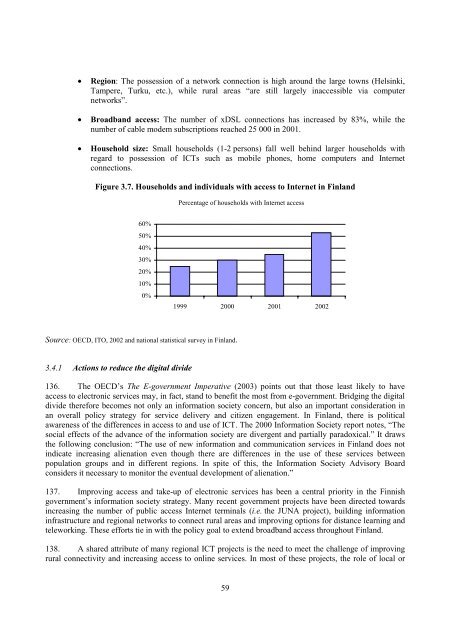e-GOVERNMENT IN FINLAND - ePractice.eu
e-GOVERNMENT IN FINLAND - ePractice.eu
e-GOVERNMENT IN FINLAND - ePractice.eu
Create successful ePaper yourself
Turn your PDF publications into a flip-book with our unique Google optimized e-Paper software.
x Region: The possession of a network connection is high around the large towns (Helsinki,<br />
Tampere, Turku, etc.), while rural areas “are still largely inaccessible via computer<br />
networks”.<br />
x Broadband access: The number of xDSL connections has increased by 83%, while the<br />
number of cable modem subscriptions reached 25 000 in 2001.<br />
x Household size: Small households (1-2 persons) fall well behind larger households with<br />
regard to possession of ICTs such as mobile phones, home computers and Internet<br />
connections.<br />
Figure 3.7. Households and individuals with access to Internet in Finland<br />
60%<br />
50%<br />
40%<br />
30%<br />
20%<br />
10%<br />
Source: OECD, ITO, 2002 and national statistical survey in Finland.<br />
0%<br />
3.4.1 Actions to reduce the digital divide<br />
Percentage of households with Internet access<br />
1999 2000 2001 2002<br />
136. The OECD’s The E-government Imperative (2003) points out that those least likely to have<br />
access to electronic services may, in fact, stand to benefit the most from e-government. Bridging the digital<br />
divide therefore becomes not only an information society concern, but also an important consideration in<br />
an overall policy strategy for service delivery and citizen engagement. In Finland, there is political<br />
awareness of the differences in access to and use of ICT. The 2000 Information Society report notes, “The<br />
social effects of the advance of the information society are divergent and partially paradoxical.” It draws<br />
the following conclusion: “The use of new information and communication services in Finland does not<br />
indicate increasing alienation even though there are differences in the use of these services between<br />
population groups and in different regions. In spite of this, the Information Society Advisory Board<br />
considers it necessary to monitor the eventual development of alienation.”<br />
137. Improving access and take-up of electronic services has been a central priority in the Finnish<br />
government’s information society strategy. Many recent government projects have been directed towards<br />
increasing the number of public access Internet terminals (i.e. the JUNA project), building information<br />
infrastructure and regional networks to connect rural areas and improving options for distance learning and<br />
teleworking. These efforts tie in with the policy goal to extend broadband access throughout Finland.<br />
138. A shared attribute of many regional ICT projects is the need to meet the challenge of improving<br />
rural connectivity and increasing access to online services. In most of these projects, the role of local or<br />
59
















